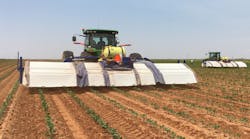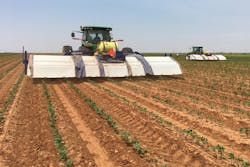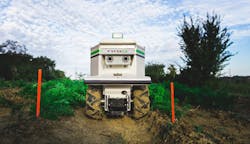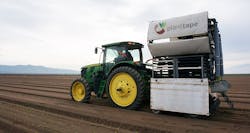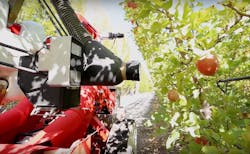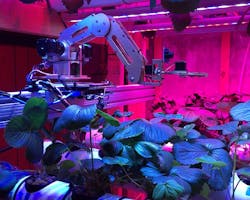In today’s industrial environment, robots appeal to several industries because they help ease labor concerns—specifically, an aging workforce and the potential to increase the efficiency of work output. This is no different in the agricultural world. Introducing robots into the fieldwork would help reduce labor concerns that are currently being experienced in both the U.S. and in Europe. Robots and new technology would also help alleviate the increase need of precision work and limitations brought on by new chemical and natural resources farming standards. However, the delicate nature of the work makes it difficult to introduce traditional industrial robots.
“Traditional robots were designed to perform very specific tasks over and over again,” said Dan Harburg, of the Dutch agriculture tech venture capital firm Anterra Capital, in a recent interview with AgFunderNews. “But the robots that will be used in food and agricultural applications will have to be much more flexible than what we’ve seen in automotive manufacturing plants in order to deal with natural variation in food products or the outdoor environment.”
While there are several areas that companies and startups can invest into, the major areas can be broken up into three main categories: seeding and weeding, harvesting, and environmental control. Each category covers major areas of agriculture that would benefit from the introduction of robotic systems and advances in technology.
Seeding and Weeding
Spraying and weeding robots help farmers two-fold. First, they reduce the amount of labor needed by eliminating a mundane task from their list of daily operations. Second, they reduce the amount of pesticides that need to be sprayed by precise targeting of crops. Farmers save on product cost while producing healthier, safer crops.
Blue River claims that its “see and spray” robots can reduce agrochemical use by 90% by using computer vision targeting.
Different tech companies have developed technology for spray robotics. Blue River Technology is a farm robotics start-up that was recently acquired by John Deere, primarily due to its spray and weeding robots. Blue River claims that its robots can reduce agrochemical use by 90%. Its tractors have a speed of 6 to 8 mph and can cover 8 to 12 rows of crops simultaneously. The tractor uses advanced vision systems to see the crops as it passes above them to provide direct targeting.
Naio Technologies have autonomous robots that use laser and camera guidance to autonomously navigate between rows of fruits and vegetables and identify different types of weeds.
Naio Technologies is a French robotic company that uses laser and camera guidance to autonomously navigate between rows of fruits and vegetables. It can recognize different types of plants to identify weeds. Its robot, Oz, runs on four electric engines and works autonomously for three hours before recharge. In autonomous mode, it follows the crop rows of the plot and weeds all without human supervision.
)
This PlantTape plant-transplanting robot packages soil and seeds into plant-able trays that are later cut and planted by automated robots.
For planting seeds, companies like PlantTape from Spain have developed a plant-transplanting robot that offers a fully integrated system of sowing the tape, germination, and nursery care. This offers a higher efficiency compared to conventional transplanting methods. The process involves creating trays of tape that holds the soil and seeds. Each tray holds up to 900 plants. Then the automated robot tractor pulls the tape from the tray, cuts the tape around each plant, and places the plant accurately in the soil. PlantTape can be used on lettuces, broccoli, cauliflower, celery, onions, and tomatoes.
Harvesting
Automation for harvesting crops is nothing new. However, specialty crops like nuts, fruits, and vegetables have yet to benefit from automation technology. Part of the problem is that the crops very in size, height, and color. They also are more delicate and require light pressure and touch for picking. Automation systems also need to be able to assess and package crops by size and quality instantly.
Abundant Robotics uses computer vision to accurately pinpoint and pick the apples via a vacuum suction robotic arm.
Abundant Robotics is one of the few companies that has tried to tackle this space. It has developed an apple-picking robot that can safely pick apples of different sizes. The robot uses computer vision to pick the apples. The apple is accurately pinpointed and a vacuum robotic arm takes it off the tree limb.
Controlled Environment Agriculture
Controlled environment agriculture (CEA) is the most likely area to benefit from automation and robots, and it’s also the easiest to convert. The factors that make harvests more predictable are replicating the services provided by nature into repetitive and less complicated automated tasks.
The controlled environment agriculture areas created by Tortuga AgTech use different levels of automation to provide scalable, sustainable, and fully automated crop production.
Tortuga AgTech uses robots in its CEA areas for horticulture productions. The company is using advanced robotics, computer vision, automation, and machine learning to tackle production problems like increased scale agriculture and labor shortages. The crops are grown in internally controlled climates and automated systems do the picking, packing, and trimming. This results in increased yields through denser layouts and optimized grow conditions.
These fields for agriculture represent the areas that automation can yield significant results with increased productivity, reduced labor, and safer crops.
